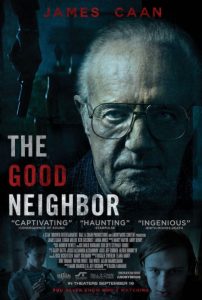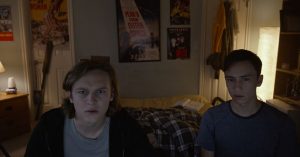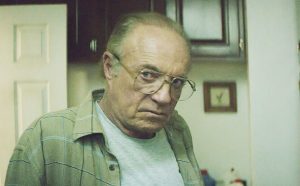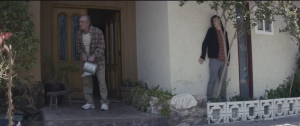
In 2007, D.J. Caruso released his film “Disturbia,” about a teenage Shia LaBeouf spying on his neighbor while under house arrest. The similarities to Alfred Hitchcock’s classic, “Rear Window,” were endless; so much so that the filmmakers and distribution company were sued for stealing the plot. While a judge ruled in favor of Caruso & Company, there’s no denying the accusation. Both films had house-stricken protagonists spying on their neighbor to stave off boredom, only to discover said neighbor was up to something possibly criminal. Their approaches may have been different, but the premise and overall tone was similar.
On the surface, “The Good Neighbor” could also be classified as a rip-off of “Rear Window.” It centers on two teenage boys, Ethan (Logan Miller) & Sean (Keir Gilchrist), spying on their neighbor via the usage of hidden surveillance cameras. Their intent isn’t out of necessity, but a cruel documentary highlighting the effects a possible haunting has on the human psyche. They’ve rigged the neighbor’s house with traps that, when triggered, make it seem as if the house is possessed. At the click of a button, they can manipulate the screen door into constantly slamming shut, adjust the temperature at an erratic speed, mess with the lights, and instill eerie sounds that echo throughout the house. The only thing they didn’t do was install props such as skeletons and ghosts to drop from the ceiling at any given moment, lest they be accused of stealing William Castle’s tricks. The goal is to see how long until the occupant is driven mad for psychological purposes. It’s inhuman and highly illegal, but it could be worse: the two could be producing videos about an annoying orange or a high-pitched man-child.

Harold Grainey (James Caan) has been chosen as the ignorant guinea pig due to his unpleasant demeanor. Legends have been told about his sadistic antics, such as berating and threatening children, poisoning a dog, and possibly even murdering his wife. If anyone is going to be driven mad, there’s nobody more deserving than this curmudgeon, the teenagers reason. They may even uncover something sinister, seeing as how his basement is padlocked shut. Why would he secure the basement when he doesn’t even bother to lock his front door?
This is where the similarities to “Rear Window” end. Kasra Farahani may hint at criminal behavior on Harold’s part, but the approach and surrounding mystery is radically different. For starters, he drops subtle hints that the teenagers may be up to no good (more so than they already are), possibly exacting revenge on the old man for a prior incident. The mystery comes more from who is truly sinister, not just what Grainey is hiding. The two elements combine to make a tantalizing experience. Even when the film starts to get predictable, it’s more akin to satisfyingly piecing together the puzzle. The twists and turns aren’t a matter of surprise but intrigue.

Farahani does a fine job of avoiding the usual pratfalls of the thriller. Even when the screenplay (credited to Mark Bianculli & Jeff Richard) presents inconsistencies and cheap contrivances, Kasra frames them in a way to complement the tone and characters. The teenagers breaking their own rules in order to service the thrills is made palatable as it highlights the vacillation of the teenage mind and plays into their desire for content. Ethan especially is obsessed with becoming internet famous, filming everything in the hopes of capturing something special. This is a clever way of working around the found footage aspect, even though the film doesn’t adhere to it. The aspect ratio jumps back and forth from found footage to traditional widescreen; sufficient at first as the former only comes into play when seeing actions from the boys’ point of view. It does become a minor nuisance, however, when Ethan is lugging around his camera at all times for no reason other than to excuse the found footage approach…despite it not being permanent. It makes sense for Ethan to film his Halloween party, as it feeds into his narcissism and heightens his depraved mindset. It doesn’t make sense, however, for him to film random conversations in front of his mother when it could’ve easily been framed in a normal aspect ratio. There is the argument that he wants Sean on camera at all times to clear himself from undue influence, but that gets trampled on occasion (possibly the point).
Another slight framing issue comes in the form of a court trial. On occasion, the film cuts to two lawyers (Tamlyn Tomita & Dean Cameron) questioning suspects involved in the crime, such as Ethan’s mother (Anne Dudek) and a police officer (Edwin Hodge). It’s never overt enough to spoil the mystery, but does diminish some of the tension thanks to its interruption. It’s kept to a minimum, but serves no purpose other than to throw in a few red herrings. There’s no reason it couldn’t have been contained to the final act.

There are also character motivations that seem questionable at first, but make sense by film’s end. Sure, some actions are incorporated solely to trick the viewer into one mindset, but most are accounted for in the long run. Howard’s descent into madness is posited in a way that can justify insanity or depression, allowing either reveal to flourish. Same goes for Ethan & Sean, hinting at ulterior motives but covering enough ground to validate their actions.
“The Good Neighbor” may not break any new ground in the thriller genre, but its direction is palpable enough to suck the viewer in. Farahani inculcates drama to uphold characterizations and motivations, in return cranking up the tension. This is gripping enough to overcome the framing issues, only dissipating the intrigue slightly. The script may adhere to the usual shortcomings, but Kasra’s tight direction and the robust performances cover the majority of them up. Like a good mystery novel, “The Good Neighbor” is an engrossing & rewarding experience!
Final Rating: B+
